Knowledge
There are many types of Agarwood – Revealing the secret of real and fake Agarwood?
The market for Agarwood is now very diverse because of the increasing demand for Agarwood, and increasingly favorable trading conditions between countries around the world. However, products from agarwood are diverse, people with experience in the industry have little to make buyers face many difficulties
Phuc Linh Agarwood, a long-time Agarwood manufacturer and trader will synthesize Agarwood How many types of Agarwood, the truth about Real Agarwood, Fake Agarwood and how to distinguish them through the following article. To understand this field, do not miss the content of the following article, hoping to have a lot of useful knowledge for you.
Overview Of Agarwood:
The incision on the Do tree’s trunk is used to make Agarwood. Natural occurrences like a fallen tree, a borer, or a jungler’s cut might cause this wound. Humans are also capable of purposefully inflicting this wound. After some time, the plant will release oil that acts as an antibiotic to soothe and guard the wound. Agarwood is the name for the wood and the quantity of oil surrounding that trunk. Agarwood is categorized according to its oil quality, which defines whether it is good or terrible quality.
Types Of Agarwood And Ways To Classify Agarwood:
How many types of Agarwood?
To present, 21 Aquilaria species have been recorded, with 13 of them being recognized as agarwood-producing species (Lee and Mohamed, 2016). However, the destructive exploitation of agarwood has had a negative impact on the wild populations of all Aquilaria species.
What is Natural Agarwood?
Natural Agarwood is a type of Agarwood that is created in a natural way, whether it is from the natural mountain source or source of planted Agarwood. Agarwood is obtained after the outer layer of wood without oil is trimmed and cleaned. Then, depending on the purpose of the user, the business people will divide them into categories and put them on the market for sale. Natural Agarwood without any processing or technology. This type of Agarwood is also divided into two types: Natural Mountain Agarwood and Planted Agarwood.
Natural Mountain Agarwood:
Natural Mountain Agarwood is a type of Agarwood created from the trunk of the Do tree that grows naturally in the mountains. Wounds and mechanisms of creating Agarwood in a natural way without any human intervention. This type of Agarwood is classified as having the highest value. Agarwood is concentrated in many Southeast Asian regions: Vietnam, Laos, Cambodia, and Indonesia. Malaysia… Natural Agarwood is currently scarce due to human hunting and exploitation.
Based on the amount of oil accumulated in the wound distinguish what kind of Agarwood is it.
Aloes:
- Aloes are the highest quality and most valuable in the Agarwood family. Aloes is classified into 4 types: Green, Iron, Purple and Black.
- The interesting method to recognize Aloes is when tasted in the mouth it feels bitter, numb at the tip of the tongue for a long time. When burning, the smoke rises straight for a long distance before dissipating. Aloes are very rare nowadays, it is not easy for Agarwood players around the world to hunt and find this source.
Agarwood:
- Below Ky Nam is Agarwood with a relatively large amount of essential oil, professional Agarwood traders classify this type of Agarwood into 7 levels from 1 to 7 based on the oil consumption of Agarwood. The market also relies on whether or not it sinks when dropping agarwood into the water to classify Agarwood.
- Agarwood type 1,2,3 are Agarwood submerged in water. Agarwood type 4,5 can sink if it was filtered out the Giac inside. Agarwood grades 6 and 7 are non-submersible agarwood.
- Agarwood has a spicy, bitter taste, when burned, it creates a straight smoke, then turns into a circle and melts. Depending on the area and type, Natural Agarwood has colors: black, dark, brown, yellow…
Toc:
- Below Agarwood Type 7 is the wood that has oil but not much and when burned it still has a very fragrant smell called Toc Agarwood.
- The outer wood, located right behind the shell with only oil rays left, is called Giac Tram.
The quality of Natural Agarwood has the same level ranked from high to low according to origin: Vietnam, Laos, Indonesia, Malaysia. In Vietnam, Agarwood in the Central region: Quang Nam – Da Nang, Khanh Hoa is the best Agarwood species

Planted Agarwood (Man-made Agarwood):
General Knowledge:
- Planted Agarwood has not have as long a time for planting and cultivating as natural Agarwood. Because the amount of oil produced is not enough to classify based on rank as Natural Agarwood. The total time from planting to harvesting takes 7-20 years. Not every Do Tree when transplanted also produces Agarwood, so the price of Man-made Agarwood is also expensive. Agarwood of this type is fragrant and is widely used in life depending on the purpose. Normally, untreated Artificial Agarwood will not sink underwater.
- Vietnam is the first country in the world to successfully research and apply agarwood cultivation techniques. Vietnam’s Artificial Agarwood also brings significant value and quality. Currently, the technology of planting agarwood has been applied to Laos, Cambodia, and Indonesia.
Classification:
Man-made Agarwood was divided into two types: Agarwood Chunk and Agarwood Chip.
- Agarwood Chunk has the shape of a nest, the inside is hollow or just a part of the wood. The wound on the stem is created by drilling or chiseling. After that, an acid or microorganism is injected to further damage the wound. Sometime later, Agarwood oil will be created around that wound. Types of Planted Agarwood in the market are usually exploited two years after the Agarwood tree produces Agarwood. The outer wood is completely removed. Next is the harvest of Giac, then Toc and the innermost part is Agarwood Chunk. The oil-free inner core is also cleaned and removed.
- Agarwood Chip is created in a thin form. To create this type of Agarwood, the wound is created by peeling off the outer bark of the tree. The woody part is then scanned with acid or micro-organisms that continue to destroy the outer bark of the trunk. This thin layer of Agarwood is cut, cleaned and called Agarwood Chip.
- The outer layer that eats less oil is called Toc and the least oily part is Giac. Depending on the purpose of use, these Agarwood species – Toc and Giac are harvested for sale.
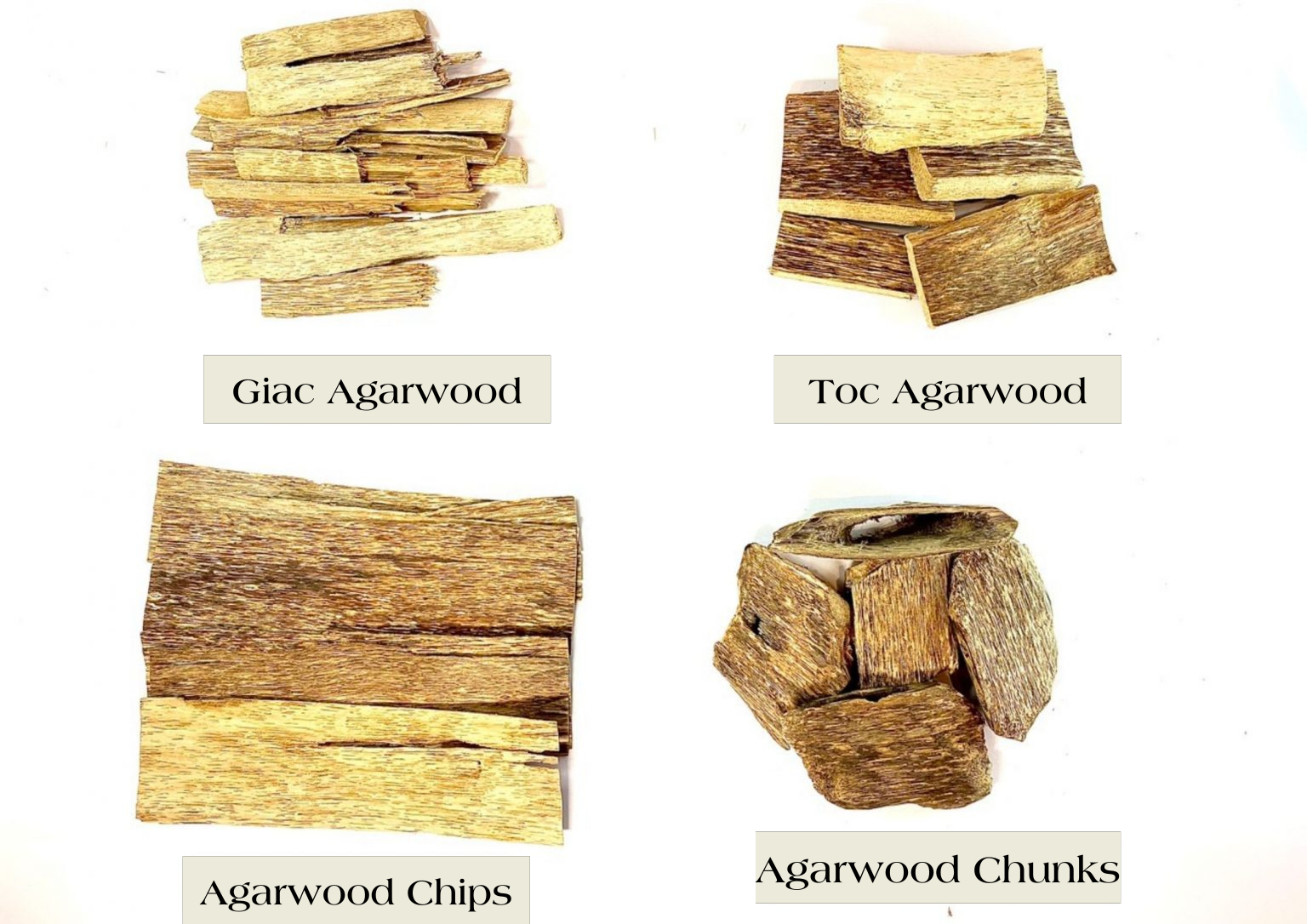
What Is Technological Agarwood?
There are two types of Agarwood that were processed by technology: Agarwood Oil Pressed and Compound Agarwood Chips.
- Agarwood Oil Pressed: Toc Agarwood is pressed with Agarwood oil extracted from Agarwood. The quality of this type of Agarwood depends on the quality of the agarwood inside; the quality and quantity of oil pressed. The Agarwood oil pressed in must be pure Agarwood oil, not mixed. The amount of Agarwood oil is pressed deeply from the inside out.
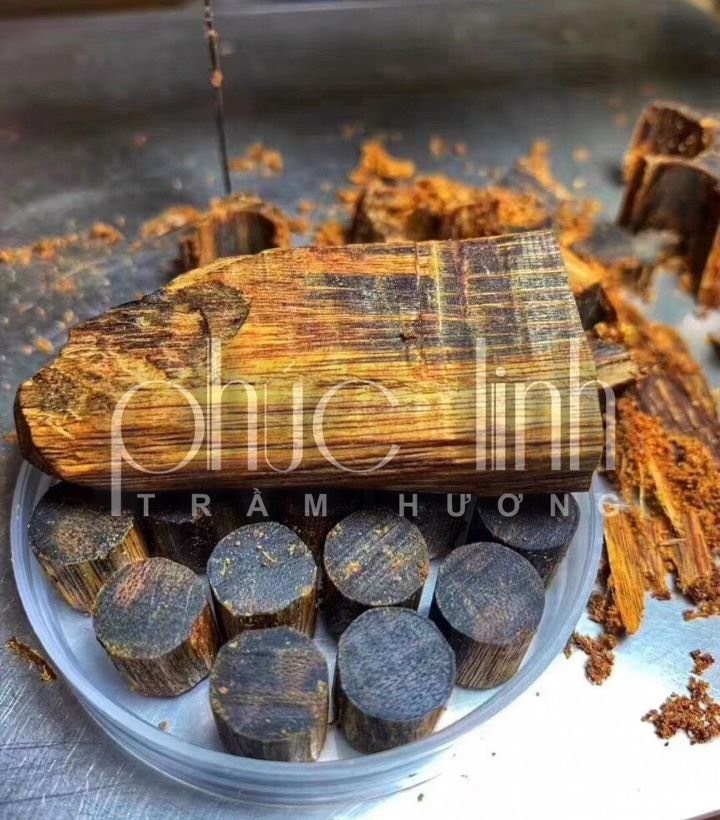
- Compound Agarwood Chips: This is a type of Agarwood created by layers of agarwood chips with the amount of essential oil assembled by glue. The quality of this type of Agarwood is determined by the quality of the combination both inside and out and the amount of glue used.
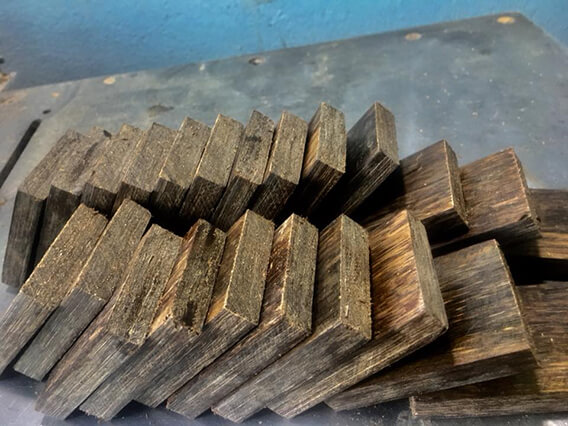
- Processed Agarwood is not pure. This type of agarwood also has a number of advantages: heavy-handed, dark, strong aroma and live aroma (scented form when smelled directly without burning). The price of this Agarwood is not too expensive. So that this overcomes the disadvantages of Natural Agarwood. Treated Agarwood is often used to make jewelry and fine art Agarwood.
- Because of the cheap source of raw materials, Processed Agarwood still has enough advantages like Natural Agarwood, so many manufacturers and traders of Agarwood have produced many products that do not guarantee quality.
Real Agarwood And Fake Agarwood, How To Distinguish Agarwood Species:
What is Real Agarwood?
Professional knowledge helps you to basicly classify Agarwood. All types of Agarwood in the above classification are real Agarwood products, whether Natural or Artificial or Technological. So what is the definition of Fake Agarwood? How to distinguish Real and Fake Agarwood?
Fake Agarwood:
Agarwood is supposed Fake Agarwood when it has the following characteristics:
- The wood has a fragrant aroma, the appearance is similar but not the wood of the Do tree that creates Agarwood
- If it is Technological Agarwood with oil pressing treatment, the oil is not real Agarwood essential oil. Or the wood inside Technological Agarwood was mixed
In our opinion, the essence of Fake Agarwood falls into two categories called basic Agarwood as above. In addition, between Fake Agarwood and Real Agarwood, there will be another concept of Pure Agarwood and Non-Pure Agarwood.
What is Pure Agarwood?
Pure Agarwood is essentially Agarwood from inside to outside, whether it is Natural Agarwood or Man-made Agarwood. Agarwood must not experience any technological processing and glue together. It also must not be pressed with Agarwood oil to increase the quality of Agarwood.

What Is Non-Pure Agarwood?
- Non-Pure Agarwood is mostly the kind of Agarwood that was processed and technologically.
- Agarwood Oil Pressed or Compound Agarwood Chips are both Non-Pure Agarwood.
Each type of Agarwood has a different price. So when buying Agarwood, the seller must clearly advise customers of agarwood species.
Is Agarwood Oil Pressed A Fake Agarwood?
- The quality of Agarwood is determined by the amount of Agarwood essential oil contained inside. Agarwood Oil Pressed is not fake Agarwood if the quality of the oil inside is pure, unadulterated agarwood oil. On the market, there are also types of oil-cooking agarwood with non-pure oil quality or chemically mixed oils. The amount of agarwood oil pressed inside is also a factor to consider.
- In addition, to determine whether agarwood products are fake or not, it is necessary to consider the type of agarwood embryos inside. Normally, Toc Agarwood is the raw material that manufacturers often use to squeeze more Agarwood oil. If the wood inside is not agarwood, it is also classified as a fake.
- Commonly, Natural Agarwood products are very expensive, but are porous, light and uncertain, so it is difficult to find and sometimes do not meet the user’s aesthetic. Oil-cooking agarwood has a strong smell, strong, easy to have large blocks, so it is suitable for making handicrafts from agarwood.
- The price of pure agarwood oil is relatively high, so Agarwood Oil Pressed is not cheap.
Is Compound Agarwood Chips A Fake Agarwood?
- Compound Agarwood Chips are also a type of Agarwood, but it is processed by Technological Agarwood. It is not Fake Agarwood if all the ingredients pressed from the inside out are all unadulterated agarwood chips
- Compound Agarwood Chip is classified as Non-Pure Agarwood due to the added amount of grafting glue. Properties of this kind of Agarwood have a beautiful agarwood vein, a natural aroma and a large embryo. These things meet the needs of making fine art products, so Agarwood Chip is still the choice of many customers.
- The quality of Compound Agarwood Chips depends on the entire amount of chips from the inside to the outside of the Agarwood embryo. Therefore, the price of this type of agarwood also has many high and low differences.
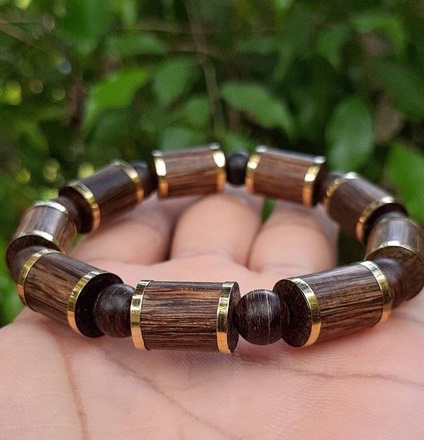
How To Recognize Real Fake Agarwood?
Overview:
This is such a good question, but it’s a tough one. The new manufacturer is the one who knows what is the nature of the Agarwood embryo. The outside of the product, when displayed on the shelf, is often eye-catching, satisfying the aesthetic needs of customers. These finished products are usually technically processed and polished.
If based on the sense of external appearance, it is difficult to determine the true nature of agarwood. To confirm whether agarwood is real or not, what is the quality inside? Therefore, the manufacturer is the one who well knows the nature of the type of agarwood. We share some experiences for you to more or less recognize the type of agarwood with the following content:
How to distinguish:
Density, polar rotation and composition of substances…. contained in Agarwood essential oil are the quality indicators of Agarwood. However, under normal conditions, Agarwood traders rely on their experience of external senses to recognize. Some relative ways of identification are as follows:
- Color: Fake Agarwood can’t show Agarwood oil veins. The color of wood without the characteristic oil rays of Agarwood.
- Shape: the mechanism, time and way of creating Agarwood also affect the form of the Agarwood embryo. Natural products often come in many different forms. Planted Agarwood usually has some generic form, certain types. Looking through the outside, you can easily recognize natural or artificially grown goods.
- Recognizing by scent: Fragrance is the pinnacle to distinguish the types of agarwood in the Agarwood business world. Each type of Agarwood, originating in the lowland region, has a different scent. People with long-term experience when burning agarwood to smell it will distinguish which type of Agarwood is.
Application Of Agarwood:
Benefits of Agarwood Oud:
Agarwood has long been known as the “King of Feng Shui” because of agarwood spiritual benefits. Agarwood activates good energy; banishes evil spirits in the living space and brings good luck to the owner.
Nowadays, agarwood is used for making objects such as agarwood statues, agarwood scenes, and pocket mahogany, displayed in the home or workplace. Agarwood or mahogany jewelry is also carried by many people to stimulate more good energy for themselves. Not only that, agarwood also brings many values and uses for a healthy life:
In Health Field:
- Agarwood contains substances that help detoxify and purify the body. Therefore, many people use agarwood to soak for making alcohol, it not only nourishes the blood but also treats abdominal pain and poisoning.
- The scent of agarwood is sweet and pleasant, so it can be burned to relax, fight depression, insomnia, stress
- The valuable components of agarwood are mainly found in essential oils, so they are often used in the form of grinding and powdered powder, not for drinking.
- Pregnant women need to be careful with medicines containing Agarwood.
In Cosmetics and Perfume Industry:
In agarwood essential oil, you may find the antioxidants Mangiferin, Terpenoids, and Cucurbitacin. Agarwood extracts are used in the cosmetic industry because they provide anti-aging benefits that improve the appearance of the skin. Yet this is only one of the research ideas that Vietnam hasn’t yet used in production. In addition, the substances contained in Agarwood essential oil are scented, so they are used by famous perfume manufacturers and researchers as a flavoring agent, helping the fragrance of the perfume to be stored for a long time.
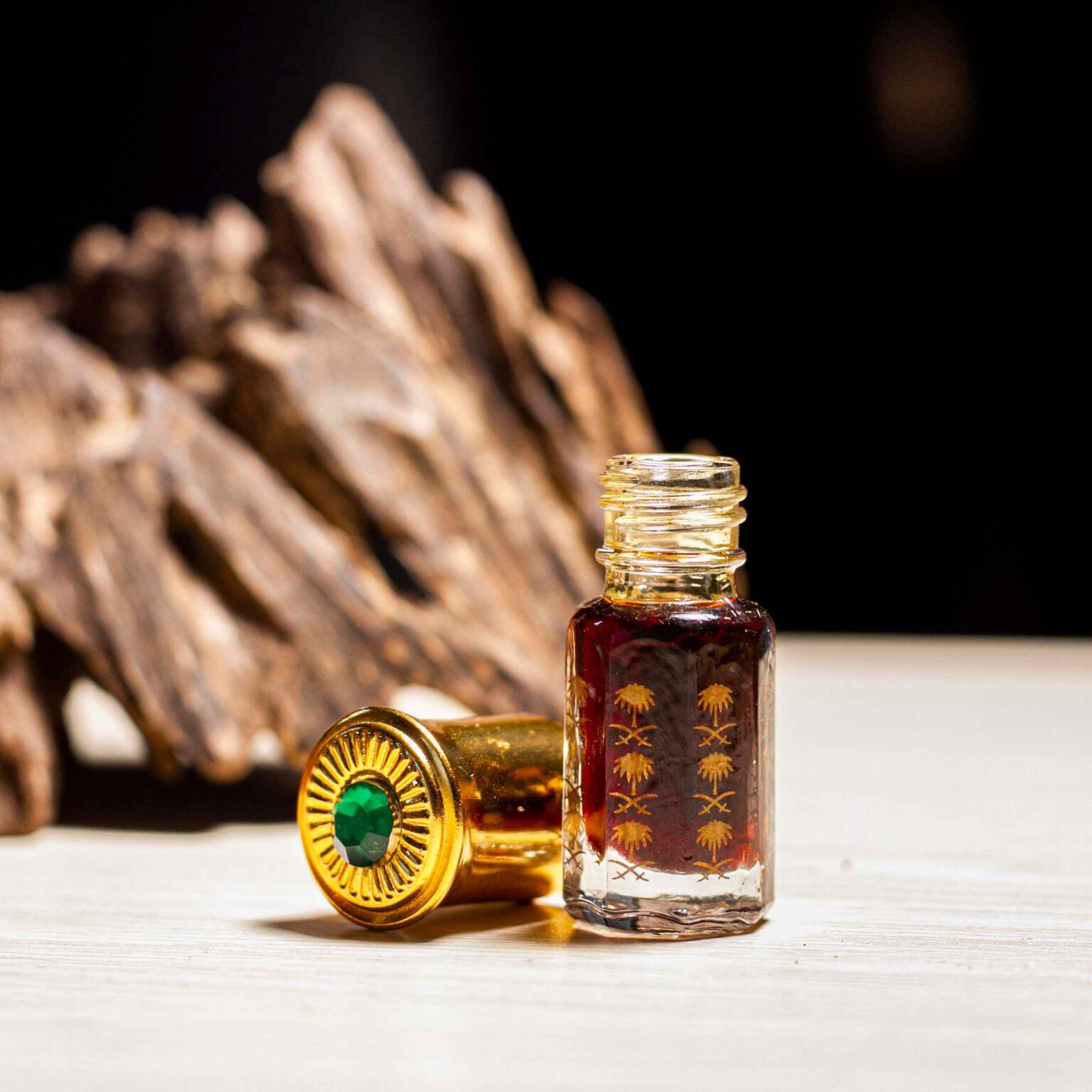
In Daily Life:
The scent from Agarwood is very deep and strong, but not harsh as well as uncomfortable. Agarwood is considered to be the most expensive and fragrant scent that no other essential oil has. Therefore, when stressed at work, people often burn a bunch of Agarwood incense to enjoy and relax
Agarwood incense, Agarwood buds, Agarwood powder are products used for daily burning to serve spiritual and worship needs. In addition, in meditation, yoga, and practice, agarwood is also used as a fragrance to support the practice process.
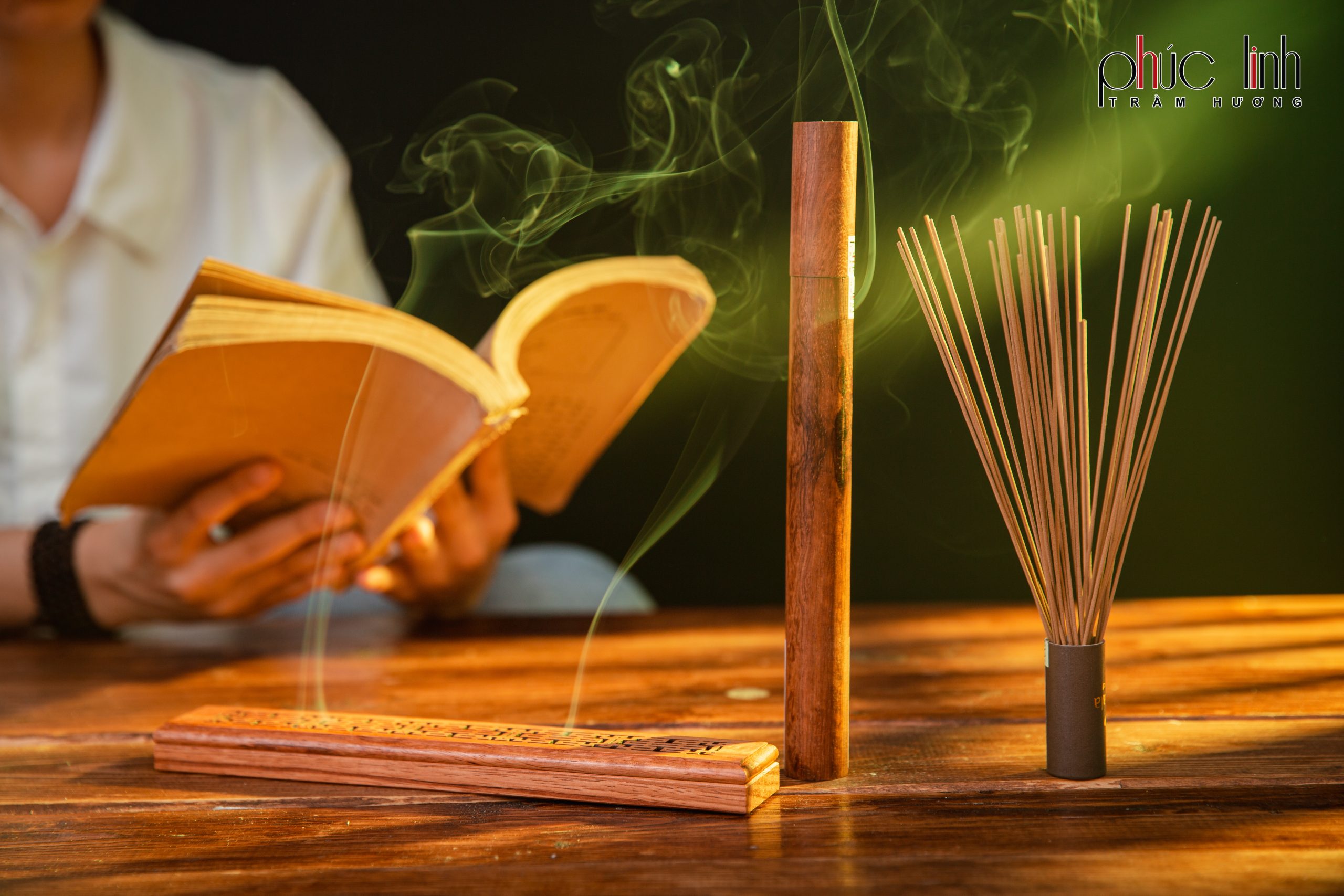
Application of Agarwood in Reality:
In spirituality and feng shui, Agarwood is the most obvious application in the daily life of Vietnamese people. The fragrance of incense is a unique feature of this product. These two elements work together to produce several goods with a wide range of practical uses:
Usage of Agarwood for Burning Purposes:
- Burning products to serve the needs of spiritual worship: Agarwood incense, Agarwood buds, Agarwood coils…
- Products used in home steaming, and deodorizing: agarwood chunk, Giac agarwood, agarwood powder
- Products used in relaxation needs: Agarwood buds, agarwood incense sticks without toothpicks, cigarette agarwood chips (this is a fairly new product on the market that is applied in life)
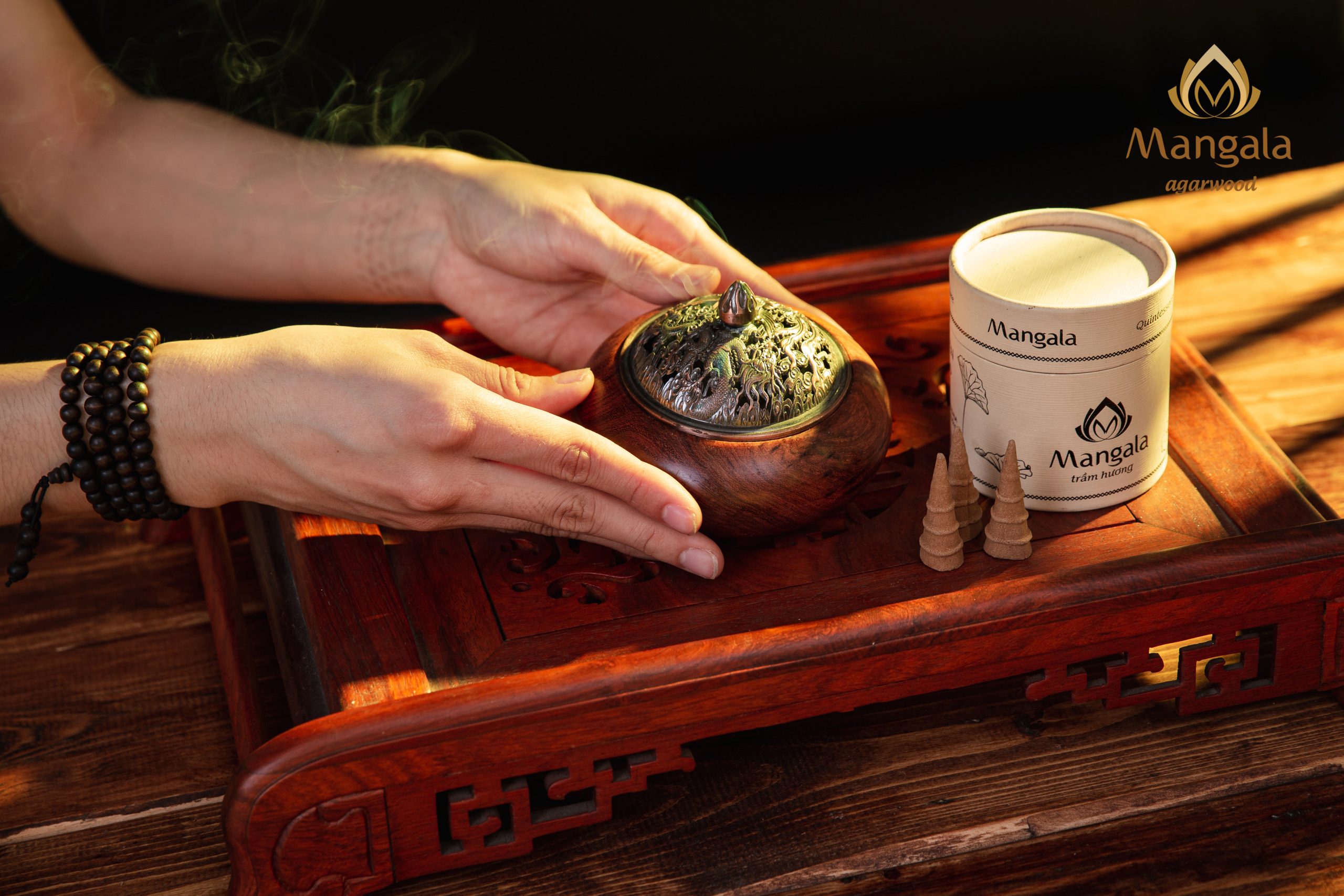
Feng Shui Agarwood:
- The positive energy index of agarwood is large, so it can activate and increase good energy for living space. Agarwood statues, agarwood fine art,… are widely chosen to be feng shui home decor items at work or in the living room.
- Agarwood statues for cars, car hangers the meaning of wishing for peace, good luck and favorable conditions for the driver and the people sitting in the car.
- Not only brings good feng shui to the space but also stimulates more fortune, prosperity and luck for yourself. Agarwood is also made into jewelry: bracelets, agarwood necklaces…. with many beautiful, trendy and healthy designs.
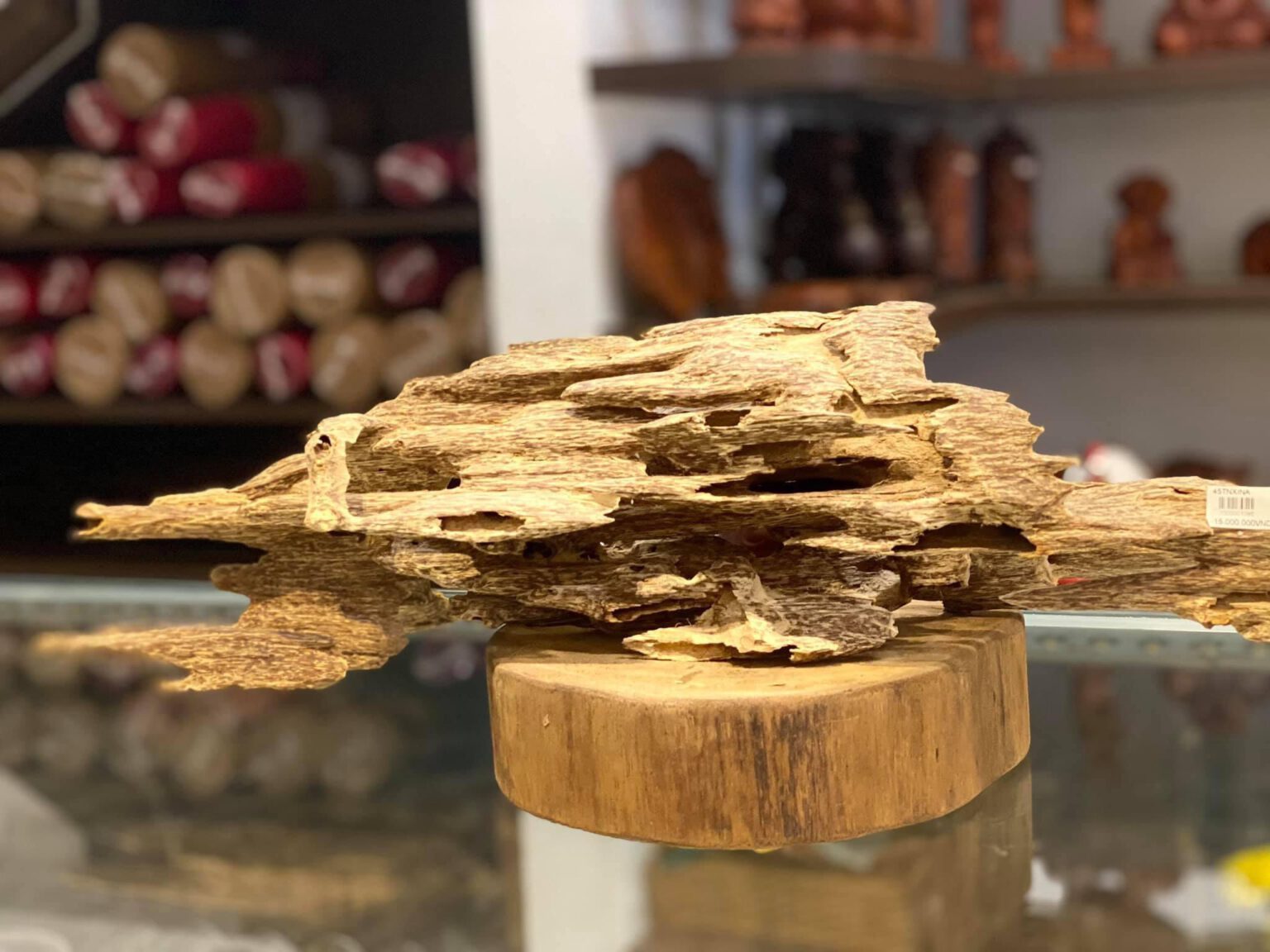
Agarwood Essential Oil:
Agarwood essential oil is used to make cosmetics and can be replaced as a perfume. It is loved by Middle Eastern countries, the United Arab Emirates and imported a lot from Asian countries.
Agarwood Gifts:
Agarwood today is researched and crafted by longtime agarwood manufacturers to produce rich, diverse and sophisticated products for gifts. Not only has a high value, but it is also beautiful and has great value that the giver wants to send. Products used as gifts from Agarwood: Agarwood Pen, Agarwood Gift Set, Agarwood tea…
Actual Situation Of Agarwood Market Nowadays:
Agarwood is a hot phrase that is interesting to business people and friends around the world. However, what is becoming hotter and hotter today is becoming more and more dangerous because many producers of agarwood for profit ignore the mind of the profession, making low-quality products. Due to the overexploitation of agarwood, natural agarwood is increasingly scarce.
For thousands of years, agarwood has been known and used by people because of its significant value. The trend and demand for using agarwood for medicinal applications, spiritual feng shui products, air purification is increasing, leading to alarming signs such as:
The Source Of Natural Agarwood Is Gradually Exhausted:
Agarwood is known as a precious product available in Southeast Asian countries. But now, about 9-10 years ago, only agarwood remains in Laos, Indonesia, Malaysia, Thailand, and Myanmar. The exploitation is so large that recently the agarwood production of the above countries is almost exhausted and scarce.
Currently, there are only 4 countries that have sources of Agarwood to supply the world market, including: Vietnam, Laos, Indonesia, Malaysia, etc. In which, Vietnam is considered the place with the highest quality and valuable agarwood quantity, compared to the other two countries. Before the 1990s, Vietnam exported nearly 15 million USD of Agarwood (Oud) per year. However, the products at that time are exported in the form of raw materials and handicrafts, so their value is not very high.
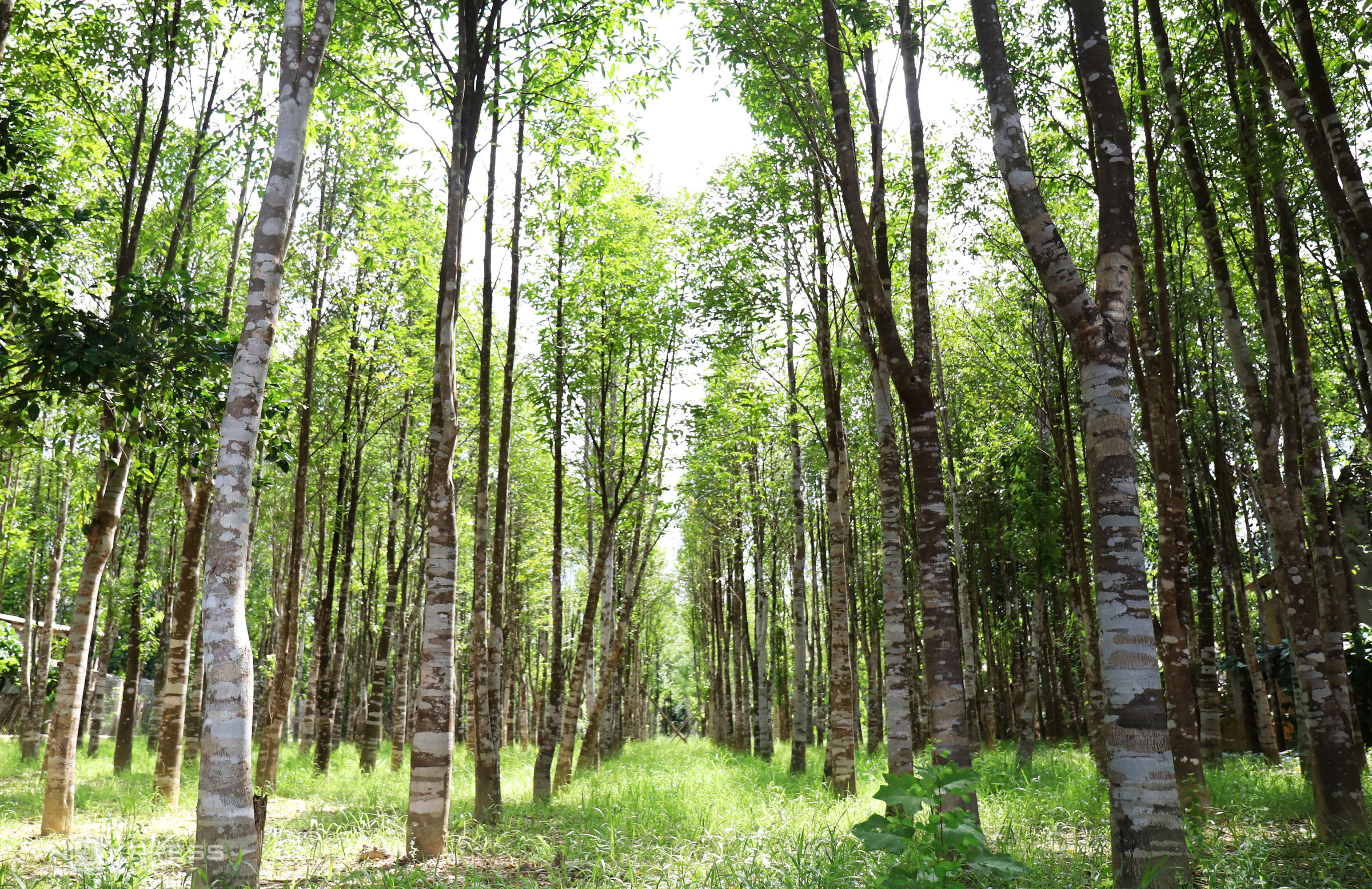
Real and Fake Agarwood on the Market:
There is a saying that buying agarwood is buying people. Why is that so? It can be said that Agarwood is a difficult profession that requires deep expertise. Many traders, if not experienced enough, are also easily mistaken, not only buyers. Determine the quality of Agarwood, it is only based on the experience of the seller.
The Agarwood market is currently pretty active when the demand for domestic and export Agarwood is increasing. That’s why there are more and more Agarwood traders.
In recent years, thanks to the Agarwood cultivation industry, the natural source of Agarwood not be threatened become exhausted when the demand for Agarwood is increasing. In addition, the market of Agarwood is imported from countries around the world: Malaysia, Indonesia. Laos…to Vietnam is also considerable.
According to the increasing demand for Agarwood Fine Arts, manufacturers gradually also create Processed Agarwood (Technological Agarwood) products. Consulting and specifying Agarwood is essential for customers to know to buy. However, not all sellers are knowledgeable or have the heart to fully advise customers, true to the nature of Agarwood.
Because of the great value of Agarwood, the market also appears Fake Agarwood. It is a type of Agarwood that is injected with oil, chemicals, and even metal inside to create weight for Agarwood.
Conclusion
Through this article, hopefully, readers have grasped what is Real Agarwood, what is Fake Agarwood and how to distinguish them. There are many types of Agarwood on the market today. This is also difficult for shoppers who do not have much experience. You need to choose a reputable place with a lot of experience for clear and thorough advice on each type. Limiting the purchase of incorrect agarwood species and suitable product prices, limiting the purchase of poor quality products at unreasonable prices. When you need more advice or information, do not hesitate to contact us through these following information:
CHAU THONG MANUFACTURING – TRADING AND SERVICE COMPANY
Manufacturer and Wholesaler and Retailer of Agarwood
PHUC LINH Agarwood and Premium Agarwood MANGALA
Hotline: +84 901.144119
Email: phuclinhagarwood@gmail.com
Address: 316 Ong Ich Khiem, Thanh Khe District, Da Nang City. Viet Nam



